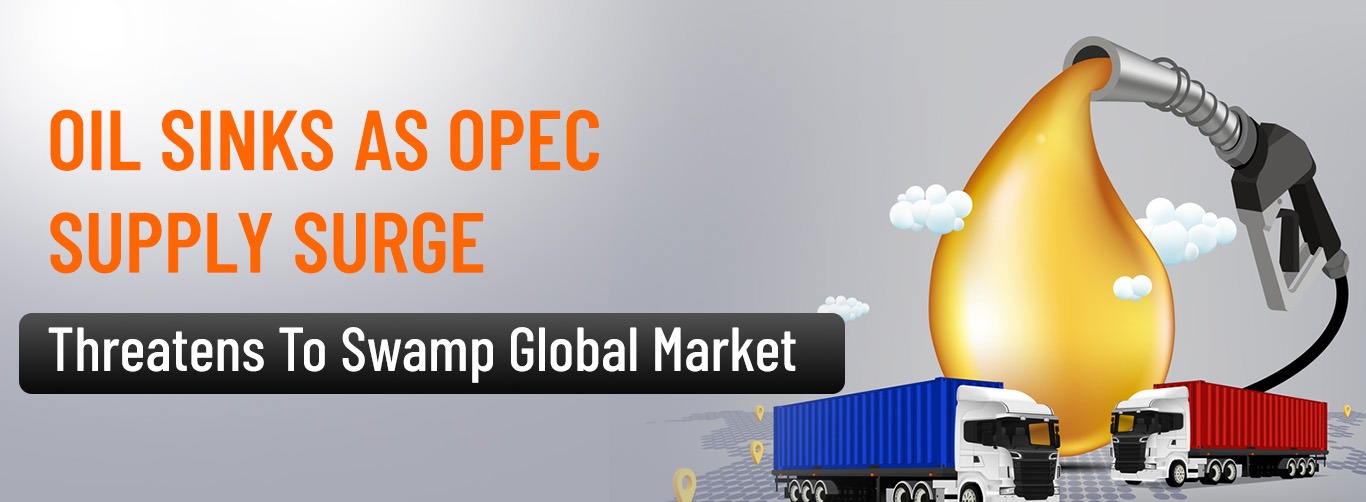Crude oil markets have taken another blow as OPEC delivered a surprise output hike for June, triggering fresh volatility and raising fears of a supply glut. With Brent crude hovering near $61 per barrel—a four-year low—the sudden pivot by the oil cartel is reshaping market dynamics and fueling broader concerns about global recession risks.
So, what’s behind this unexpected move by OPEC? And how might this impact oil prices, energy companies, and inflation-sensitive economies going forward?
Let’s break it down.
OPEC+ Turns the Taps Back On
In a virtual meeting on Saturday, eight key OPEC members, led by Saudi Arabia and Russia, agreed to raise output by 411,000 barrels per day (bpd) in June. This comes on the heels of a similar hike for May, effectively tripling the group’s previously planned volume increase.
This is not a one-off. Sources indicate that OPEC plans to accelerate production hikes through October, potentially unwinding as much as 2.2 million bpd of voluntary cuts by November—a major reversal from its previous stance of defending higher prices.
What’s more, Saudi Arabia appears to be sending a dual message:
- Discipline overproducers like Iraq and Kazakhstan, who repeatedly exceed their output quotas.
- Appease U.S. President Donald Trump, who has publicly demanded lower oil prices ahead of his May visit to the Middle East.
As Jorge Leon of Rystad Energy put it, “OPEC has just thrown a bombshell to the oil market. Saudi Arabia is seeking to punish lack of compliance and ingratiate itself with President Trump.”
Prices Plunge as Supply Fears Mount
The market response has been swift and unforgiving. Brent crude dropped another 6% following the announcement, extending a steep decline fueled by weak global demand, rising recession risks, and uncertainty surrounding international trade policies.
Several major forecasters have issued sharp downgrades to their oil price projections, citing heightened volatility and mounting economic headwinds. Revised estimates now place Brent prices significantly lower for 2025, with expectations for only a modest recovery by 2026.
Adding to the bearish tone, analysts warn that oil demand growth could shrink by as much as 500,000 barrels per day if the global macroeconomic environment continues to deteriorate.
Why the Pivot? Power Play Meets Politics
OPEC’s about-face is as much about internal politics as it is about market dynamics.
Saudi Arabia has grown increasingly frustrated with non-compliance from members like Kazakhstan, which overshot its March target by a staggering 422,000 bpd. Riyadh’s message is clear: toe the line—or risk a price collapse.
The Kingdom is also realigning its geopolitical strategy, seemingly warming to Trump’s agenda amid tense nuclear negotiations with Iran and economic strain from low oil revenues. Notably, the IMF recently downgraded Saudi Arabia’s outlook, citing the need for $90+ oil to balance government budgets.
Ironically, by opening the taps, Saudi Arabia is risking its own financial stability—but possibly hoping to regain market share, enforce discipline, and curry favor with Washington in one bold move.
Winners, Losers, and the Road Ahead
The OPEC+ shift is rippling across the energy landscape:
- U.S. shale producers—once urged to “drill, baby, drill”—now face collapsing prices that threaten project viability.
- Oil-dependent economies like Iraq, Algeria, and even Saudi Arabia are bracing for fiscal pain as prices flirt with breakeven levels.
- Global consumers, on the other hand, may welcome cheaper fuel, though it remains to be seen how much relief reaches end users amid ongoing inflation.
Investment plans in the Gulf are already being scaled back. Flagship projects like Saudi Arabia’s Neom city have seen funding cuts, highlighting the fiscal stress caused by the price slide.
For now, OPEC has signaled a clear intent to prioritize compliance and market share over price stability. The group is expected to reconvene on June 1 to decide output levels for July—and if compliance doesn’t improve, further hikes could follow.
What Do Experts Say?
Market analysts agree that this is a pivotal moment for oil markets.
“OPEC+ is shifting from price defense to a market-share war,” said Giovanni Staunovo, analyst at UBS. “Until compliance improves, prices will remain under pressure.”
Others warn that Saudi Arabia’s strategy, while bold, risks backfiring. “The ‘sweating’ of rogue members hasn’t worked yet,” noted Helima Croft of RBC Capital Markets. “Kazakhstan is still defiant, and Iraq’s compliance is patchy at best.”
Energy strategists also note that aligning with Trump’s inflation-fighting goals may yield short-term gains, but could leave the cartel vulnerable to future political shifts.
Conclusion
OPEC’s decision to flood the market marks a historic departure from its long-standing role as price stabilizer. With oil prices plunging, demand faltering, and internal cohesion under strain, the cartel is now navigating uncharted waters.
Whether this strategy restores compliance—or triggers a new price war—remains to be seen. For now, one thing is clear: the oil market is entering a new era of volatility, and producers and consumers alike must prepare for the fallout.
Disclaimer: This article is for informational purposes only and should not be considered as investment advice

Leave a Reply